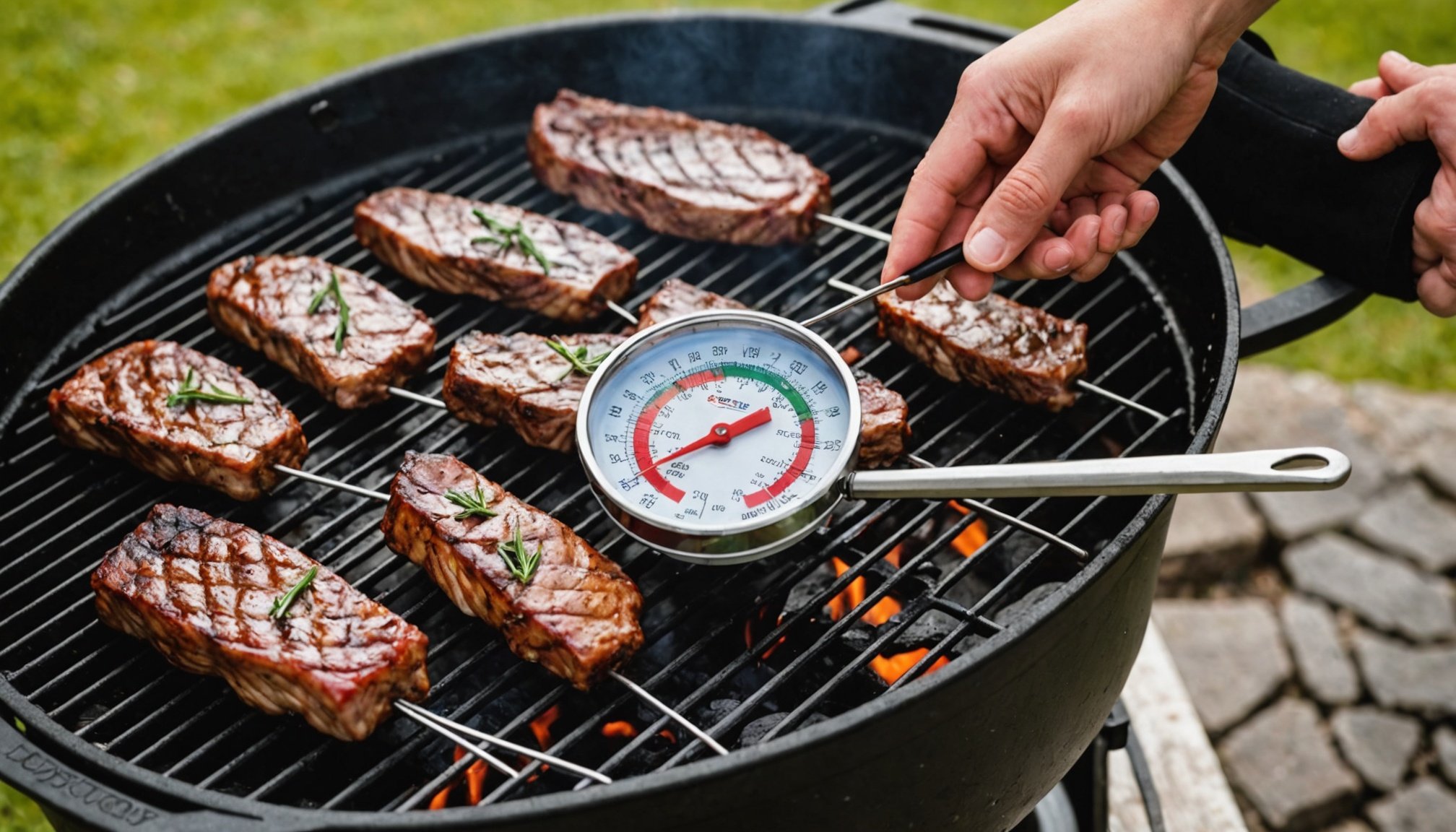Overview of Meat Thermometers
Understanding the types of meat thermometers is essential for ensuring perfectly cooked meals. Meat thermometers come in various forms, each tailored to different needs.
Types of Meat Thermometers
-
Digital Thermometers: These offer precise readings, often displaying temperatures in seconds. They are user-friendly and typically include backlit displays for easy reading during barbecues.
Also read : Unbreakable Kitchen Tables: Essential Durable Surfaces for Busy Homes
-
Analog Thermometers: Known for their durability, they do not require batteries and often cost less. They might take longer to display temperatures but are ideal for slow, consistent cooking.
-
Infrared Thermometers: Although not inserted into the meat, these measure surface temperatures effectively. They are best for spot-checking grill temperatures rather than meat interiors.
Also to read : Unlock Perfect Portions: Your Ultimate Guide to Choosing the Best Cooking Oil Dispenser
Importance for BBQ
Using a meat thermometer is crucial in ensuring meat is cooked at the right temperature, enhancing both safety and taste. Overcooked or undercooked meat can spoil your barbecue experience, while properly measured temperatures ensure juicy, delicious results.
Key Functionalities
- Digital: Quick readout, often paired with calibration options.
- Analog: Simplicity with no power source needed.
- Infrared: Suitable for maintaining consistent grill temperatures.
Understanding these key functionalities allows for informed decisions on the right thermometer for your needs.
Key Features to Consider
When choosing meat thermometers, considering both accuracy and temperature ranges is vital. Accurate readings ensure meats are cooked to safe temperatures, while suitable temperature ranges accommodate different cooking needs—from rare steaks to well-done roasts. A precise thermometer prevents overcooking or undercooking, ultimately enhancing meal quality.
Convenience plays a significant role in a meat thermometer’s usability. Look for models with easy-to-read displays and straightforward controls. Backlit screens are particularly beneficial for outdoor cooking in low-light conditions. Features such as audible alerts can further simplify the cooking process by notifying you when meat reaches the desired temperature without constant monitoring.
Response time is another crucial factor to evaluate. Faster thermometers deliver immediate results, reducing the time meat spends outside the oven or grill, thereby maintaining optimal cooking conditions. Additionally, ease of cleaning can influence convenience. Waterproof models allow for simple washing under running water, and stainless-steel probes minimize complications during cleanup.
Considering these features will lead to a well-informed purchase, ensuring your meat thermometer meets your cooking demands. With these in mind, the selection process becomes clearer, allowing you to focus on preparing delicious meals with confidence.
Comparative Analysis of Popular Models
Navigating the realm of meat thermometers can be daunting given the multitude of options available. Selecting the right model involves understanding different functionalities and how they cater to specific cooking needs.
Digital vs. Analog Thermometers
Digital thermometers boast quick response times and calibration features, ideal for precise cooking methods. They’re best for scenarios demanding swift temperature adjustments, such as grilling steaks. Analog thermometers, while slower, are lauded for their reliability and no-fuss usage—perfect for slow-cooked meals.
Infrared Thermometers vs. Probe Thermometers
Infrared thermometers excel in measuring surface temperatures, beneficial for grill management. However, they fall short in gauging internal meat temperatures. In contrast, probe thermometers directly measure internal heat, ensuring meat is cooked safely from the inside.
Budget-Friendly Options vs. Premium Choices
Budget-friendly models might lack advanced features but offer satisfactory performance for occasional cooks. Premium options provide enhanced accuracy and durability, fitting for avid culinary enthusiasts or professionals. Consider your cooking frequency and environments to determine the best fit.
Recommendations should align with intended cooking styles, ensuring your thermometer optimally enhances your culinary ventures.
Practical Tips for Effective Use
Incorporating the use of meat thermometers into your cooking routine can revolutionize your culinary outcomes, ensuring precision and safety. One crucial aspect is the correct insertion of the thermometer. For best results, insert it into the thickest part of the meat, avoiding bone or gristle, which can lead to inaccurate readings.
When grilling, aim to insert the thermometer from the side of the meat rather than the top for a more accurate assessment of its internal temperature. In smoking, it’s often best to monitor the temperature periodically, as the cooking dynamics can vary significantly between different smokers and types of meat.
Using meat thermometers doesn’t merely stop at inserting and reading. Identifying the ideal temperature for different meats is vital for maintaining quality. A simple technique like double-checking the readout after a few seconds can enhance accuracy.
Also, consider deftly using the thermometer during the resting phase of meats; internal temperatures can rise slightly as they rest. This prevents overcooking, ultimately delivering more tender and juicy dishes. With these practical tips, your meat thermometer becomes an indispensable tool in achieving consistent and delicious results.
Food Safety and Thermometers
Comprehending safe cooking temperature guidelines is essential for both delicious and secure meals. A meat thermometer plays a critical role in verifying that food reaches temperatures that kill harmful bacteria. For instance, poultry should attain an internal temperature of 165°F, while beef and lamb may be safe at lower temperatures depending on the doneness preferred. Using thermometers ensures such guidelines are met, diminishing the risk of foodborne illnesses.
Incorporating a meat thermometer into your cooking routine transforms your approach to food safety. Regular calibration and maintenance of the device are essential to attain accurate readings. Calibration involves comparing your thermometer’s reading against a known temperature standard, ensuring reliability over time. This practice is particularly crucial in preventing erroneous readings that could compromise safety.
Moreover, frequent usage demands thorough cleaning and inspection for wear and tear, especially in the probe area where residue may build up. Understanding these safe cooking temperatures and the preventative role of thermometers is indispensable for prudent food preparation. By prioritising these practices, you significantly enhance your culinary safety and quality, safeguarding your dining experiences against potential health hazards.
Troubleshooting Common Issues
Navigating the world of meat thermometers sometimes calls for patience and problem-solving. Identifying and addressing inaccurate readings is crucial. A primary issue could be an uncalibrated thermometer. Regular calibration ensures accuracy; immerse the probe in ice water and boiling water to verify its performance.
Slow response times can be frustrating. This may be due to a low-quality sensor or a drained battery in digital models. Upgrading to a model with a more responsive sensor or freshly charged battery can significantly improve performance. For analog models, ensure the dial is functioning smoothly without any obstructions.
Another pitfall is common user mistakes. Inserting a thermometer wrongly—touching bone or being too shallow—can skew readings. For precise measurements, aim for the centre of the thickest part of the meat, away from bone and fat.
Understanding how to troubleshoot these issues equips you to make the most of your meat thermometer. By identifying and resolving these common problems, you ensure more reliable and consistent results, enhancing both the safety and quality of your cooking.

